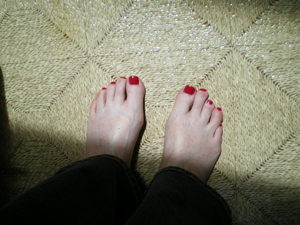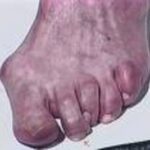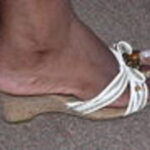We all know that pedicures can make our toes look pretty for summer sandals, or just for our own pleasure, and they make our feet feel pampered. But did you know that regular pedicures, whether in a spa or salon, or done by yourself at home, can help keep your feet healthy?
There are three major types of problems that regular pedicures can help prevent or repair. The first of these includes calluses and corns. Calluses are caused by a build-up of dead skin cells on your feet; those cells get harder over time and the affected area can spread. They usually start from pressure on the bottom of your feet or toes from too-tight shoes. They can become painful, even though they’re your foot’s attempt to cushion itself from the pressure. Corns, too, are an accumulation of dead skin cells, but they occur on the top and sides of your foot and on the tips of your toes, and can be very painful.
Calluses and corns can be prevented first by wearing shoes that fit properly and have a square rather than a pointy toe box – in other words, sensible shoes, not sexy ones. The other way to prevent them is by regular pedicures, at least one a week. Soak your feet in warm water for at least 5 minutes; 10 if it feels oh-so-good. Add bath salts to the water with pine or mint, both for pampering and to soften the developing dead skin build-ups. Then dry your feet thoroughly, making sure to dry between the toes, and buff the areas on the bottoms and tops of your feet where you detect the beginning of calluses. Use a pumice stone or a foot-file, and rub gently until your feet are smooth. Then apply an antibacterial foot lotion to them.
The second type of problem that regular pedicures can prevent are foot fungi, whether it’s athlete’s foot or toenail fungus. The athlete’s foot fungus starts as an itch, followed by red, dry, flaking skin. If you don’t deal with athlete’s foot immediately, it can spread to your hands and to your toenails, and to other people who share your shower or towel.
You can prevent athlete’s foot by good foot hygiene, like the good soak and cleaning provided by a pedicure. If you already have athlete’s foot, you may need to use an anti-fungal cream, but before you apply, soak and clean your feet and dry them completely. Until your athlete’s foot infection is cured, wear socks that will wick moisture away from your feet, since fungus loves a dark, warm, damp environment; use clean towels every day, since infected towels can re-infect your feet; and wear flip-flops into any public shower, like the ones at the pool or the gym. The same preventative measures – the regular thorough cleaning and drying a pedicure provides – can prevent a fungal infection under your nails. If you do get fungus under your nails, regular pedicures can help to clear it up, used along with either an over-the-counter fungal cream or one prescribed by a podiatrist.
Finally, regular pedicures can prevent ingrown toenails. There are few things more painful to your feet than ingrown toenails; they appear when the skin on one or both sides of a toenail grow over the nail. They can become red, irritated, and even infected. While there are many causes for ingrown toenails, by far the most common is improperly cutting your nails. To prevent ingrown toenails from this cause, cut your toenails straight across, and make sure that the corners of the nail are visible. If you curve the cut of the toenail, you’re just asking for an ingrown nail. Use an emery board to smooth the top of the nail, but make sure you can see it all. Also, don’t wear socks, hose, or shoes that are too tight, as they can also cause ingrown toenails.
To treat ingrown nails, make a part of your pedicure a foot soak in warm salt water, then dry your feet and toes completely with a fresh towel. Apply an antiseptic to the affected toe, and put a bandage on it. You may need to see a podiatrist to actually cure an ingrown toenail; in her office, she can remove the infected nail, or excise some of the tissue around the nail, and give you instructions for post-procedure care.
To sum it up, pretty feet are also healthy feet. Whether you go to a salon, or to your kitchen, give yourself a pedicure at least once a week. It’s not just pampering; it’s preventive health care.
(Sources: http://www.marieclaire.com/hair-beauty/trends/articles/perfect-pedicure-1 , http://www.foot.com/info/cond_calluses.jsp, http://www.foot.com/info/cond_corns.jsp. http://www.foot.com/info/cond_athletes_foot.jsp , http://www.foot.com/info/cond_ingrown_toenails.jsp , http://www.foot.com/info/cond_toenail_fungus.jsp, http://findarticles.com/p/articles/mi_m0KGB/is_3_4/ai_n6006088/ , http://www.mydr.com.au/skin-hair/feet-how-to-care-for-your-feet, http://www.healthline.com/hlbook/dia-foot-hygiene, http://ndep.nih.gov/publications/OnlineVersion.aspx?NdepId=NDEP-4 , http://beauty.iloveindia.com/foot-care/foot-care-tips.html)





